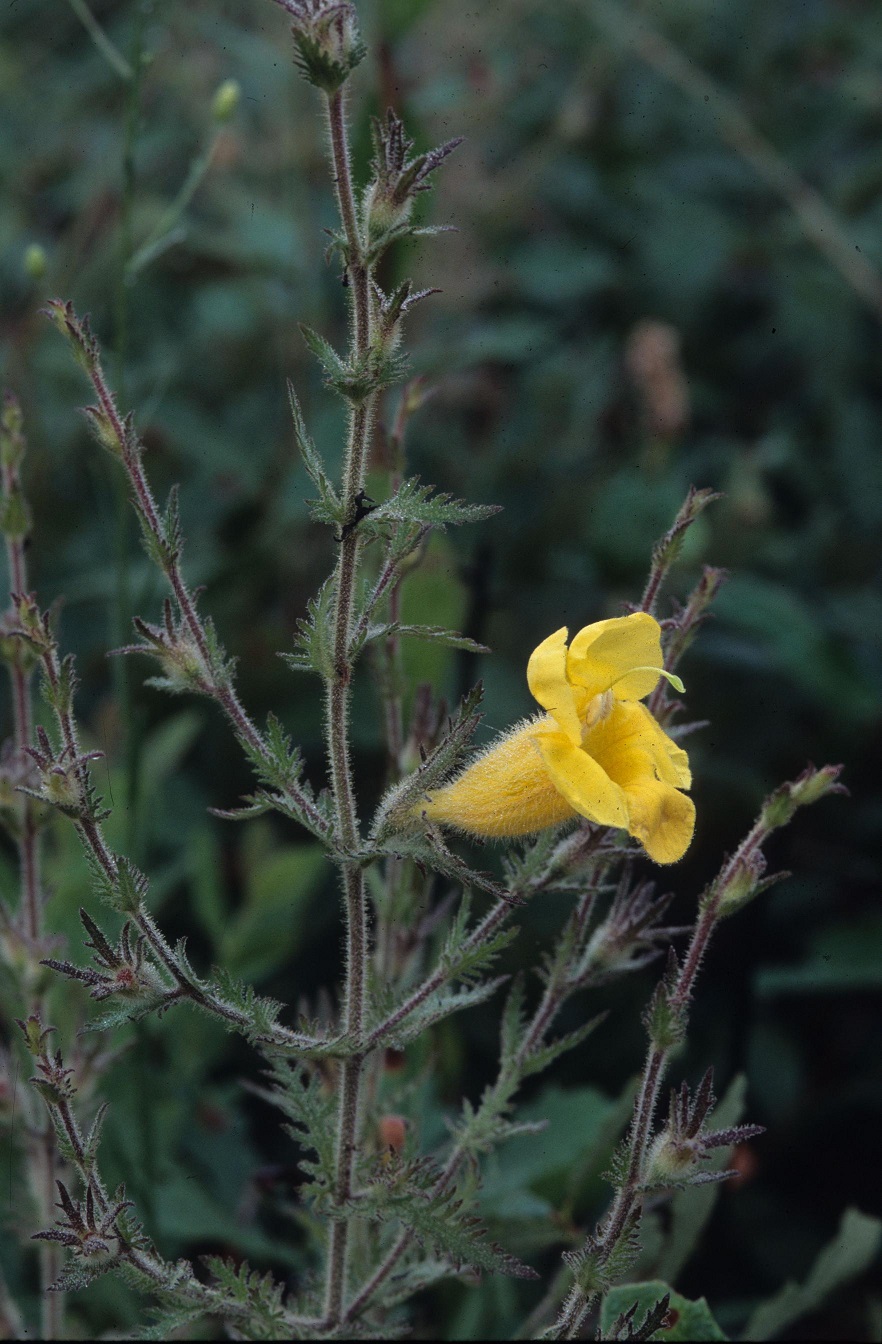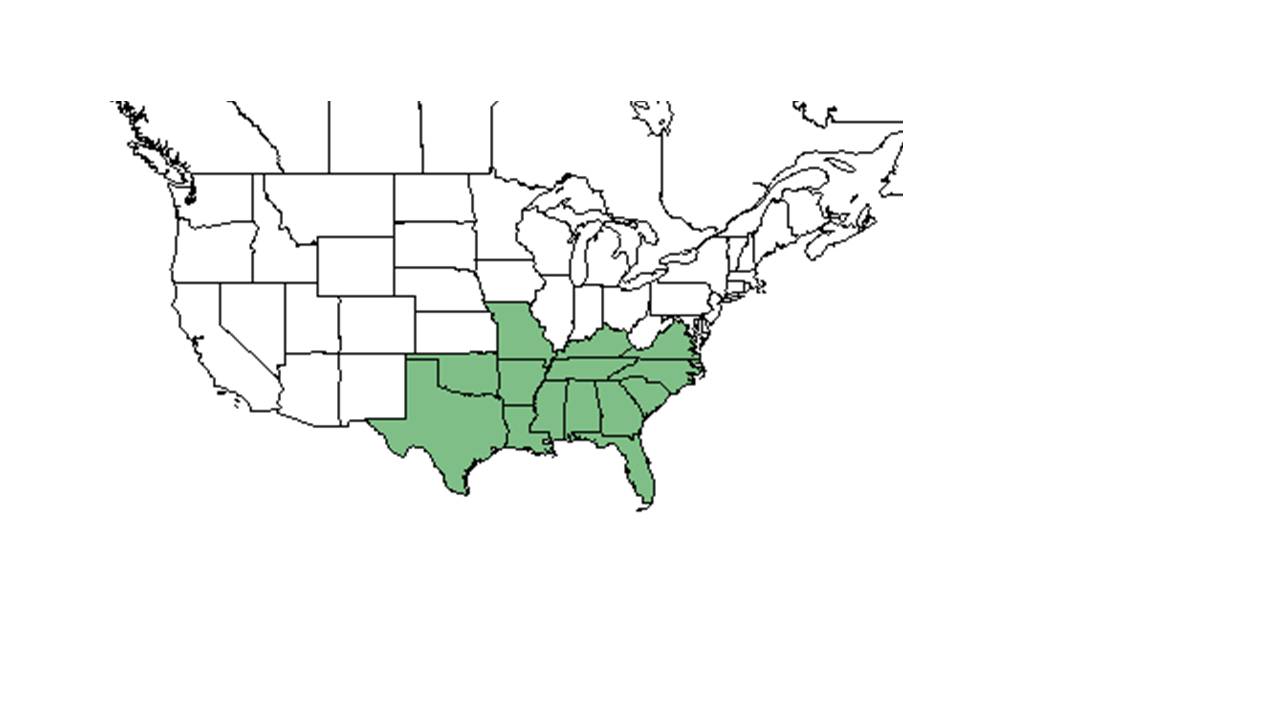Difference between revisions of "Aureolaria pectinata"
KatieMccoy (talk | contribs) |
(→Description) |
||
| Line 24: | Line 24: | ||
<!-- Basic life history facts such as annual/perrenial, monoecious/dioecious, root morphology, seed type, etc. --> | <!-- Basic life history facts such as annual/perrenial, monoecious/dioecious, root morphology, seed type, etc. --> | ||
''A. pectinata'' has opposite, fern like leaves which are pinnately incised, with sticky glandular hairs <ref name="NativeandNaturalized">[[http://www.namethatplant.net/plantdetail.shtml?plant=2563 Native and Naturalized Plants of the Carolinas and Georgia]] Accessed November 30, 2015. </ref>. It is a hemiparasitic plant that attaches modified roots to the roots of host plants, such as oaks <ref name="Arkansas">[[http://anps.org/2014/10/03/know-your-natives-yellow-false-foxgloves/ Arkansas Native Plant Society]] Accessed November 30, 2015</ref>. | ''A. pectinata'' has opposite, fern like leaves which are pinnately incised, with sticky glandular hairs <ref name="NativeandNaturalized">[[http://www.namethatplant.net/plantdetail.shtml?plant=2563 Native and Naturalized Plants of the Carolinas and Georgia]] Accessed November 30, 2015. </ref>. It is a hemiparasitic plant that attaches modified roots to the roots of host plants, such as oaks <ref name="Arkansas">[[http://anps.org/2014/10/03/know-your-natives-yellow-false-foxgloves/ Arkansas Native Plant Society]] Accessed November 30, 2015</ref>. | ||
| + | |||
| + | According to Radford (1964) ''A. pectinata'' is very similar to ''A. pedicularia''. Wunderlin and Hansen (2011) recognize ''A. pectinata'' and do not recognize ''A. pedicularia''. | ||
| + | |||
| + | In the genus ''Aureolaria'', the plants are either annual or perennial. They are parasitic on the roots of ''Quercus'' (oaks) and they turn black when dried. The cauline leaves are opposite or subopposite. The flowers are showy, the calyx is 5-parted, the lobes are shorter to longer than the tube. The corolla is yellow in color, bilabiate, and 5-parted. The tube is campanulate and the lobes are spreading. There are 4 stamens, didynamous, included, filaments are flattened, and the 2 longer more or less lanose. The anther sacs are basally awned. The stigma is capitate and exserted. (Radford 1964). | ||
| + | |||
| + | Radford described ''A. pectinata'' to be very similar to and integrated ''A. pedicularia''. ''A. pectinata'' species usually have glandular-pubescent throughout the plant. The leaves are pubescent to villous, and some of the trichomes can be glandular. The capsule is ovoid and the base is enclosed in the calyx tube. Flowers from May to September; and from September to October. (Radford 1964). | ||
==Distribution== | ==Distribution== | ||
Revision as of 17:12, 18 December 2015
| Aureolaria pectinata | |
|---|---|

| |
| Photo was taken by Gil Nelson | |
| Scientific classification | |
| Kingdom: | Plantae |
| Division: | Magnoliophyta - Flowering plants |
| Class: | Magnoliopsida - Dicotyledons |
| Order: | Lamiales |
| Family: | Orobanchaceae |
| Genus: | Aureolaria |
| Species: | A. pectinata |
| Binomial name | |
| Aureolaria pectinata (Nutt.) Pennell | |

| |
| Natural range of Aureolaria pectinata from USDA NRCS Plants Database. | |
Common Name: Combleaf Yellow False Foxglove
Contents
Taxonomic notes
Synonym: Gerardia pectinata
Description
A. pectinata has opposite, fern like leaves which are pinnately incised, with sticky glandular hairs [1]. It is a hemiparasitic plant that attaches modified roots to the roots of host plants, such as oaks [2].
According to Radford (1964) A. pectinata is very similar to A. pedicularia. Wunderlin and Hansen (2011) recognize A. pectinata and do not recognize A. pedicularia.
In the genus Aureolaria, the plants are either annual or perennial. They are parasitic on the roots of Quercus (oaks) and they turn black when dried. The cauline leaves are opposite or subopposite. The flowers are showy, the calyx is 5-parted, the lobes are shorter to longer than the tube. The corolla is yellow in color, bilabiate, and 5-parted. The tube is campanulate and the lobes are spreading. There are 4 stamens, didynamous, included, filaments are flattened, and the 2 longer more or less lanose. The anther sacs are basally awned. The stigma is capitate and exserted. (Radford 1964).
Radford described A. pectinata to be very similar to and integrated A. pedicularia. A. pectinata species usually have glandular-pubescent throughout the plant. The leaves are pubescent to villous, and some of the trichomes can be glandular. The capsule is ovoid and the base is enclosed in the calyx tube. Flowers from May to September; and from September to October. (Radford 1964).
Distribution
Ecology
Habitat
A. pectinata can occur in turkey oak sandhills, longleaf pine communities, upland hardwood forests, savannas, glades, stream banks and slash pineland [3] [1] (FSU Herbarium).
Associated species include Pinus elliottii, Serenoa repens, Quercus geminata, Q. myrtifolia, Q. chapmanii, Liatris elegans, L. tenuifolia, and Salvia azurea (UF Herbarium).
Phenology
A. pectinata has bisexual, yellow flowers that bloom spring, summer, and fall. The ovary is superior and fruits in a capsule summer and fall [1]. The flower buds have a reddish tip, while the calyx is densely hairy [2].
Fire ecology
Studies have observed that A. pectinata does not occur in unburned sites, but does occur in burned sites (Harrod et al. 2000; Kush et al. 2000). Kush et al. (2000) found that A. pectinata occurred in biennially burned longleaf pine stands regardless of burning season. In Harrod et al. (2000) it was observed growing in a burned xeric hardwood site.
Pollination
Hummingbirds and bumblebees pollinate Aureolaria pectinata [2].
Use by animals
It is the larval host plant for the Baltimore checkerspot butterfly (Euphydryas phaeton)[2].
Diseases and parasites
Conservation and Management
Conservation status: Global: G5 [4].
Photo Gallery
References and notes
Florida State University Robert K. Godfrey Herbarium database. URL: http://herbarium.bio.fsu.edu. Last accessed: June 2014. Collectors: Robert K. Godfrey. States and Counties: Florida: Wakulla.
Harrod, J. C., M. E. Harmon, et al. (2000). "Post-fire succession and 20th century reduction in fire frequency on xeric southern Appalachian sites." Journal of Vegetation Science 11: 465-472.
Kush, J. S., R. S. Meldahl, et al. (2000). Understory plant community response to season of burn in natural longleaf pine forests. Proceedings 21st Tall Timbers Fire Ecology Conference. Fire and forest ecology: innovative silviculture & vegetation management, Tallahassee, FL, Tall Timbers Research, Inc.
University of Florida Herbarium database. URL: [1]. Last accessed: November 2015. Collectors: Steven P. Christman, Nancy Coile, Brenda Herring, Robin B. Huck, Jean Huffman. States and Counties: Florida: Collier, Sarasota, Suwannee, Wakulla. South Carolina: Aiken.
- ↑ 1.0 1.1 1.2 [Native and Naturalized Plants of the Carolinas and Georgia] Accessed November 30, 2015.
- ↑ 2.0 2.1 2.2 2.3 [Arkansas Native Plant Society] Accessed November 30, 2015
- ↑ [Missouri Department of Conservation] Accessed November 30, 2015
- ↑ [NatureServe] Accessed November 30, 2015